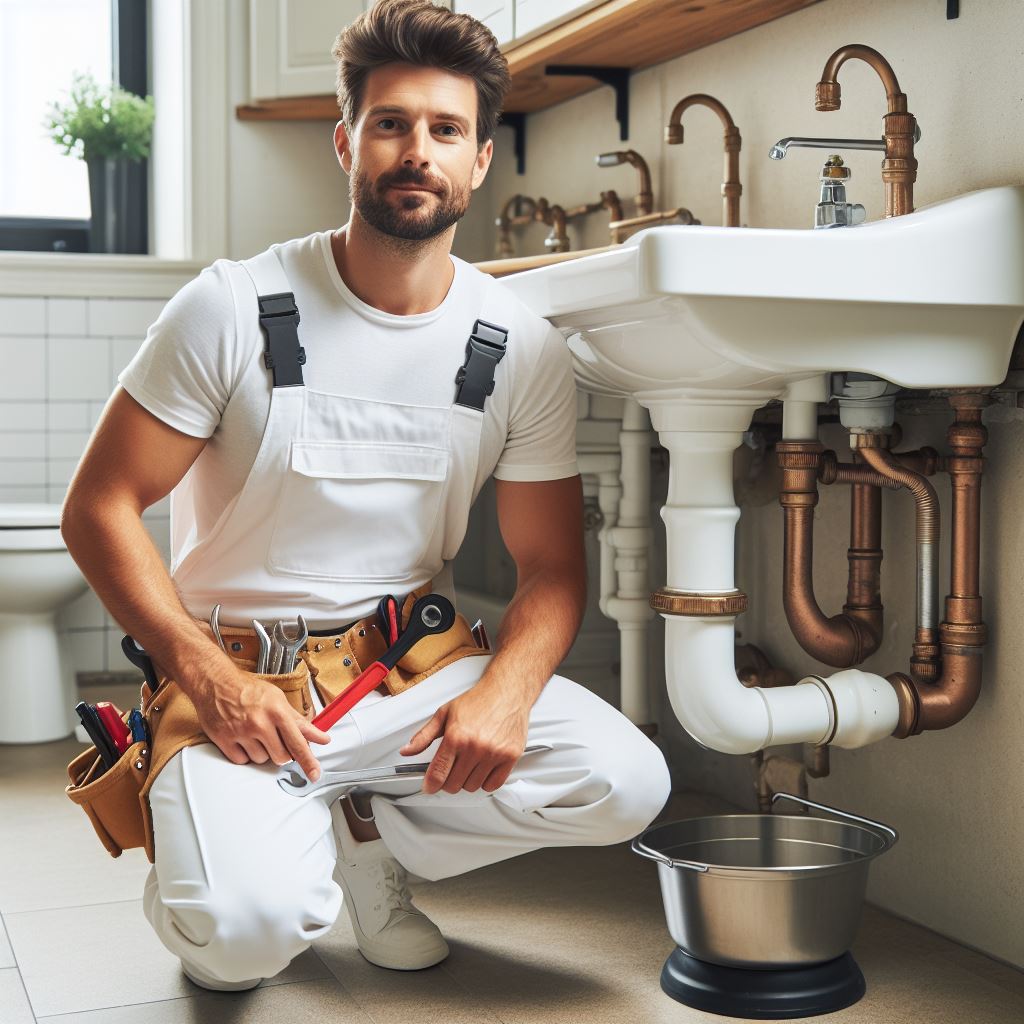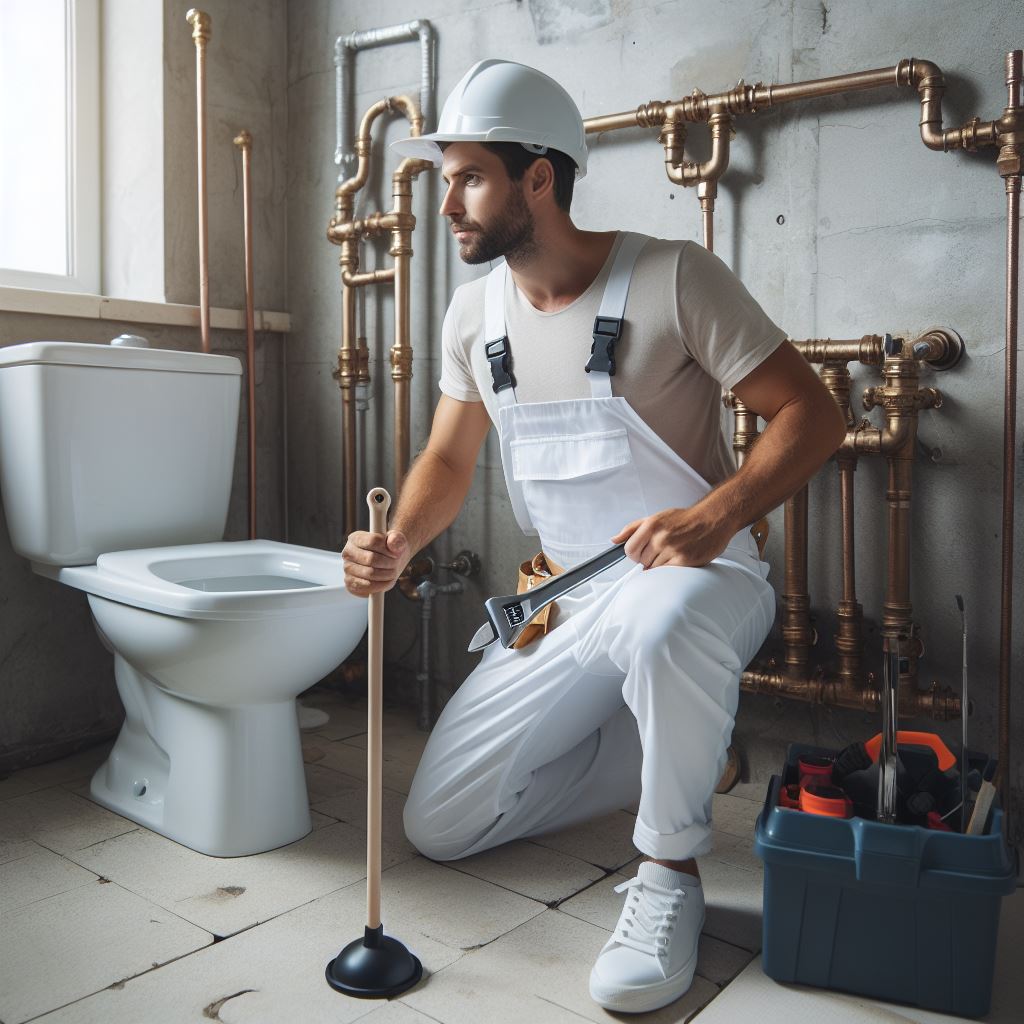Introduction
Staying updated with the latest plumbing trends in the Canadian market is crucial.
It is of utmost importance for homeowners, plumbers, and businesses involved in the plumbing industry. Understanding these trends can greatly benefit everyone in this field.
Embark on a journey through the ever-evolving Canadian plumbing scene, where traditional craftsmanship intertwines seamlessly with modern advancements.
This blog post aims to provide an overview of the latest plumbing trends in Canada, shedding light on the advancements and innovations in this industry.
In this comprehensive exploration, we navigate the currents of sustainability, witnessing the surge in eco-friendly plumbing solutions that align with the nation’s commitment to environmental stewardship.
Moreover, our exploration extends to the technological forefront, where smart plumbing systems redefine efficiency and convenience.
From intelligent leak detection to digitally controlled water temperature, discover how innovation is reshaping the user experience and promoting resource conservation.
Beyond the technical realm, the Canadian market is witnessing a surge in aesthetically pleasing and customizable plumbing fixtures, catering to the diverse tastes of homeowners.
Explore the fusion of functionality and design as we unravel the trends influencing the aesthetics of kitchens and bathrooms across the country.
Join us in unraveling the tapestry of the latest plumbing trends in Canada, where tradition meets innovation, and functionality harmonizes with style.
Whether you’re a homeowner, industry professional, or simply intrigued by the fluid dynamics of this essential trade, this exploration promises insights into the forefront of Canadian plumbing.
Trend 1: Water Conservation and Sustainability
The growing importance of water conservation and sustainability in the Canadian plumbing industry
Water conservation and sustainability have become increasingly important in the Canadian plumbing industry.
The growing awareness of water scarcity and the need to protect the environment has led to the adoption of innovative technologies.
These advancements in plumbing systems aim to reduce water consumption and minimize the environmental impact.
Innovative technologies such as low-flow toilets, water-efficient faucets, and rainwater harvesting system
1. Low-flow Toilets
One of the key trends in water conservation is the use of low-flow toilets.
These toilets are designed to use significantly less water compared to traditional ones.
They typically utilize less than 1.6 gallons per flush, which is much lower than older models.
2. Water-efficient Faucets
Another innovation in the plumbing industry is the introduction of water-efficient faucets.
These faucets are designed with aerators that mix air with water, reducing overall water usage.
They can reduce water flow by up to 30% without sacrificing performance.
3. Rainwater Harvesting Systems
Many Canadians are now embracing the concept of rainwater harvesting.
This involves capturing and storing rainwater for various uses, such as toilets, outdoor irrigation, and washing machines.
Rainwater harvesting systems help reduce the reliance on municipal water supplies and conserve freshwater resources.
4. Dual Flush Toilets
Dual flush toilets offer users the option to choose between a half-flush for liquid waste and a full flush for solid waste.
This feature significantly reduces water usage, as liquid waste does not require the same amount of water as solid waste.
Unlock Your Career Potential
Visualize a clear path to success with our tailored Career Consulting service. Personalized insights in just 1-3 days.
Get StartedDual flush toilets are becoming increasingly popular in residential and commercial buildings.
5. Smart Water Management Systems
Advancements in technology have also led to the development of smart water management systems.
These systems use sensors and data analytics to monitor and control water usage in real-time.
Users can track their water consumption, identify leaks, and adjust settings for optimal water efficiency.
6. Greywater Recycling
The reuse of greywater, which includes water from sinks, showers, and washing machines, has gained attention in Canada.
Greywater recycling systems treat and filter this water, making it suitable for purposes like toilet flushing and landscape irrigation.
This reduces the demand for fresh water and helps conserve resources.
7. Water-Efficient Showerheads
Showering accounts for a significant portion of residential water usage.
Water-efficient showerheads are designed to minimize water wastage while providing a satisfying shower experience.
These showerheads utilize technologies such as aerators and flow restrictors to reduce water consumption without compromising on water pressure.
8. Education and Awareness Campaigns
To further promote water conservation and sustainability, various organizations and governmental bodies in Canada have launched education and awareness campaigns.
These initiatives aim to educate people about water-saving practices, the importance of fixing leaks, and the benefits of using water-efficient plumbing fixtures.
These trends reflect the growing commitment of the Canadian plumbing industry towards sustainable and efficient water management.
By adopting these innovative technologies and promoting responsible water usage, the industry is actively contributing to environmental conservation and ensuring the availability of water resources for future generations.
Read: Safety Tips for Plumbers: A Canadian Perspective
Trend 2: Smart Plumbing Systems
The concept of smart plumbing systems and their integration with home automation and Internet of Things (IoT) technology
Smart plumbing systems refer to the integration of home automation and Internet of Things (IoT) technology into plumbing systems.
These systems use sensors, connected devices, and data analysis to provide efficient and convenient solutions for homeowners.
Here are some key points to consider:
Benefits of Smart Plumbing Systems
- Real-time monitoring: Smart plumbing systems allow homeowners to monitor their plumbing infrastructure in real-time. They can receive alerts and notifications about any issues, such as leaks or water pressure fluctuations.
- Leak detection: One of the significant advantages of smart plumbing systems is early leak detection. The sensors installed in the plumbing network can detect even the slightest leak and notify the homeowner immediately. This enables prompt repairs, reducing water waste and potential damage.
- Energy efficiency: Smart plumbing systems can help conserve energy by optimizing water usage. For instance, they can automatically adjust water flow and temperature based on specific needs, reducing energy consumption and utility bills.
Examples of Smart Plumbing Products in the Canadian Market
With the growing demand for smart homes, several innovative plumbing products have emerged in the Canadian market.
These products offer advanced features and seamless integration with home automation systems.
Some notable examples include:
- Smart faucets: These faucets have built-in sensors that can detect movement and automatically turn the water on and off. They are convenient, hygienic, and help conserve water.
- Smart toilets: Smart toilets come with various features such as heated seats, automatic flushing, and self-cleaning capabilities. Some models even have integrated bidet functions, offering enhanced comfort and hygiene.
- Smart shower systems: These systems allow users to control water temperature, flow rate, and even customize shower settings through smartphone apps. They offer a personalized showering experience and reduce water wastage.
- Smart water heaters: These water heaters can be programmed to heat water only when needed, optimizing energy consumption. They also provide real-time energy usage data, helping homeowners make informed decisions about their energy consumption.
- Smart leak detection systems: These systems utilize sensors placed in critical areas of the plumbing network to monitor water flow and detect leaks or abnormalities. They send instant alerts to homeowners’ smartphones, preventing potential water damage.
In short, smart plumbing systems offer a range of benefits, including real-time monitoring, leak detection, and energy efficiency.
They not only provide convenience for homeowners but also contribute to water conservation and cost savings.
With the availability of various smart plumbing products in the Canadian market, homeowners have the opportunity to upgrade their plumbing infrastructure and embrace the future of smart homes.
Read: Apprenticeship in Plumbing: A Canadian Overview
Trend 3: Green Plumbing Practices
Green plumbing has become a significant trend in the Canadian market, with a growing focus on eco-friendly materials and installation techniques.
This section explores the concept of green plumbing, the use of renewable energy sources for water heating, and the increasing popularity of green plumbing certifications and standards in Canada.
Explaining the concept of green plumbing
Green plumbing is a sustainable approach to plumbing that aims to minimize the environmental impact by conserving water, reducing energy consumption, and utilizing eco-friendly materials.
It involves the use of innovative technologies and practices that contribute to a more sustainable future.
Eco-friendly materials and installation techniques
Green plumbing emphasizes the use of eco-friendly materials such as low-flow fixtures, water-efficient appliances, and reclaimed/recycled plumbing components.
These materials help conserve water and reduce waste.
Additionally, installation techniques focus on minimizing water and energy requirements during the construction process.
Renewable energy sources for water heating
Solar thermal systems have gained popularity for water heating in green plumbing.
These systems utilize renewable energy from the sun to heat water, reducing the reliance on traditional fossil fuel-based water heaters.
Solar thermal systems are not only energy-efficient but also contribute to reducing greenhouse gas emissions.
Growing popularity of green plumbing certifications and standards
In Canada, there has been an increasing demand for green plumbing certifications and adherence to sustainable plumbing standards.
Various organizations offer certifications such as LEED (Leadership in Energy and Environmental Design) for plumbing professionals who adopt green plumbing practices.
These certifications provide credibility and assurance to customers, further driving the adoption of green plumbing practices.
List of green plumbing certifications in Canada
- LEED for Plumbing
- WaterSense
- EcoLogo
- Green Plumbers
- Living Building Challenge
The Green Plumbers certification program deserves a special mention as it offers comprehensive training to plumbers in sustainable plumbing practices across Canada.
The program covers topics such as water efficiency, energy efficiency, climate care, and the use of environmentally preferable technologies.
List of sustainable plumbing standards in Canada
- Canada Green Building Council (CaGBC) LEED standards
- National Plumbing Code of Canada
- Canadian Standards Association (CSA) B128 Series
These standards outline the requirements and guidelines for sustainable plumbing systems, ensuring that installations meet environmentally friendly criteria.
In fact, green plumbing has become a significant trend in the Canadian market, focusing on eco-friendly materials, renewable energy sources, and adherence to certifications and standards.
Plumbing professionals who embrace green plumbing practices contribute to a more sustainable future, while customers benefit from reduced water consumption, energy savings, and lower environmental impact.
Read: Plumbing Codes in Canada: What You Should Know

Trend 4: Aging Infrastructure Solutions
The issue of aging infrastructure in Canada and its impact on the plumbing industry
As Canada’s infrastructure ages, the impact on the plumbing industry cannot be ignored.
However, the industry has been quick to respond with innovative solutions to address this challenge.
The latest trends in infrastructure renewal, including pipe relining and trenchless technology
Let’s explore some of the latest trends in infrastructure renewal:
Pipe Relining
One of the most effective solutions to aging infrastructure is pipe relining.
This technique involves inserting a new liner inside the existing pipe, essentially creating a pipe within a pipe. It eliminates the need for extensive excavation and replacement.
Trenchless Technology
Trenchless technology has revolutionized the way plumbing repairs are conducted.
It allows for repairs or replacements to be done with minimal excavation, reducing disruptions to the surrounding infrastructure and minimizing downtime for businesses and residents.
Reduced Disruptions
By utilizing pipe relining and trenchless technology, disruptions caused by traditional plumbing repairs are significantly minimized.
This is especially crucial in densely populated urban areas where excavation can disrupt traffic, utilities, and daily activities.
Cost Reduction
The traditional method of digging up and replacing aging pipes is not only time-consuming but also expensive.
However, with the advent of pipe relining and trenchless technology, costs associated with excavation, materials, and labor are reduced significantly.
Longevity and Durability
Infrastructure renewal through pipe relining and trenchless technology ensures that repaired or replaced pipes have increased longevity and durability.
The new liners are resistant to corrosion and other damage, providing a longer lifespan and reducing the need for future repairs.
Environmentally Friendly
The use of pipe relining and trenchless technology also has environmental benefits.
It minimizes the amount of waste generated from excavation and reduces the carbon footprint associated with traditional plumbing repairs.
Increased Efficiency
The use of innovative solutions like pipe relining and trenchless technology streamlines the repair process, allowing for quicker completion of projects.
This increased efficiency benefits both plumbing professionals and their clients.
Adoption Challenges
While aging infrastructure solutions have proven to be highly effective, there are challenges to their widespread adoption.
Limited awareness and the initial investment required can sometimes deter stakeholders from embracing these innovative techniques.
Continued Research and Development
To maximize the benefits of aging infrastructure solutions, ongoing research and development efforts are essential.
Plumbing industry professionals and manufacturers are consistently working towards improving and refining these techniques.
Government Support
The Canadian government plays a vital role in encouraging the adoption of aging infrastructure solutions.
Providing incentives, grants, and creating awareness campaigns can help overcome barriers and drive industry-wide transformation.
In essence, the plumbing industry in Canada is facing the challenges posed by aging infrastructure head-on.
With the introduction of pipe relining and trenchless technology, disruptions and costs are significantly reduced, while the longevity and durability of repaired or replaced pipes are increased.
Despite the challenges in widespread adoption, continued research and government support can pave the way for a more efficient and sustainable plumbing industry.
Read: Essential Tools Every Canadian Plumber Needs
Trend 5: Digital Plumbing Marketing and Services
The importance of digital marketing strategies for plumbing businesses in the Canadian market
The Canadian plumbing market is increasingly recognizing the importance of digital marketing strategies.
The use of online platforms, social media, and digital advertising to reach customers
Online platforms provide an excellent opportunity for plumbing businesses to reach their target customers.
Social media platforms like Facebook, Instagram, and Twitter allow plumbers to promote their services to a wider audience.
Digital advertising helps plumbing companies generate leads and increase their customer base.
Having a strong online presence is crucial in today’s digital age for plumbing businesses to stay competitive.
By utilizing digital marketing techniques, plumbing companies can showcase their expertise and build trust with potential customers.
The benefits of offering digital plumbing services, such as online scheduling and virtual consultations
One of the major benefits of offering digital plumbing services is the convenience it offers to customers.
Online scheduling allows customers to book appointments at their convenience, saving them time and hassle.
Virtual consultations enable plumbers to assess customer needs remotely, providing quick and efficient solutions.
Customers appreciate the convenience of accessing plumbing services digitally, especially during emergencies.
By offering digital services, plumbing businesses can provide a seamless customer experience, increasing customer satisfaction.
Digital marketing also allows plumbing companies to target specific customer demographics for effective marketing campaigns.
Plumbing businesses can analyze data from online platforms to better understand customer preferences and tailor their marketing efforts.
Through digital marketing, plumbers can engage with customers through blog posts, videos, and informative content.
Providing valuable information to customers helps establish authority and credibility for plumbing businesses.
Online reviews and testimonials play a significant role in shaping the perception of the plumbing business.
Positive reviews and ratings can significantly impact the success and reputation of a plumbing company.
By monitoring online reviews, plumbing businesses can address customer concerns and improve their services.
Digital marketing allows plumbing companies to easily collect and manage customer feedback, enhancing their service quality.
Plumbing businesses can leverage digital marketing to stay ahead of their competition and attract new customers.
Using search engine optimization (SEO) techniques, plumbers can increase their online visibility and rank higher on search engine results.
Investing in digital marketing strategies can generate a high return on investment (ROI) for plumbing companies.
Compared to traditional forms of advertising, digital marketing offers excellent cost-effectiveness for plumbing businesses.
Uncover the Details: The History of Plumbing in Canada: A Journey
Conclusion
Staying updated with the latest plumbing trends is essential for both consumers and professionals.
It allows consumers to take advantage of new technologies and features that can improve their plumbing systems and make their lives easier.
For professionals, keeping up with these trends ensures they can offer the most advanced and efficient solutions to their clients.
By exploring these trends further, readers can gain a deeper understanding of how these innovations can benefit their own plumbing needs or business operations.
Whether it’s the growing popularity of eco-friendly plumbing fixtures or the advancements in smart home technology, there is something for everyone to consider.
It is crucial to recognize the significance of staying informed and embracing these changes in the Canadian plumbing market.
Ignoring these trends may lead to missed opportunities for cost savings, improved efficiency, and better overall functionality.
As the industry evolves, it is important to adapt and embrace the latest advancements to stay ahead of the game.
Staying up-to-date with the latest plumbing trends is not only beneficial but necessary in today’s rapidly changing world.
So take the time to explore these trends further, assess their relevance to your own plumbing needs or business operations, and make informed decisions that can enhance your overall plumbing experience.




